-
Posts
5,589 -
Joined
-
Last visited
-
Days Won
15
Posts posted by LongLeftFlank
-
-
I will assume you're being cute here, Jon. As you know perfectly well, the guns opened fire on March 13 and the main camp fell on May 7, nearly 2 months later.
The Peoples Army had to take the various outposts, one after another, the old fashioned way, by breaching the wire barriers and blasting the dugouts with grenades up close and personal. While I am skeptical of the 20-25,000 VM casualties estimated by the French (again, we Westerners cling to a deep-rooted meme/terror of being overwhelmed by screaming Asiatic hordes that goes back to Thermopylae at least), most of these assaults were extremely costly and many were failures. In precisely no case were the defenders eliminated or driven out by fire in spite of the dominant tactical positions of the Viet Minh.
In fact, I defy you to find me an example pre 1990 where a prepared position held by a disciplined force has been annihilated solely by fire, allowing an attacker to simply walk in. Yet this result is routinely the case in CMBN.
Kettler -- you are welcome too. Just keep it brief please.
-
Still LLF, all the other stuff is impressive, but thats a really great workaround for illum rounds. I'm very impressed with your creative thinking with this and the dead HT. brilliant.
In another attempt to replicate an illumination round, I tried combining the burning pole visual with a TRP. Unfortunately, you can't bring in a TRP as a reinforcement (yes, I understand why), so it's there from the start.
I just had a terribly frustrating playtest, gaming out a small night action involving a VietMinh sapper unit (a Panzershreck* team, a Breach team and a Scout team -- 8 men, Crack/Extreme) probing the wire entanglements (~level 8) in front of a French (Airborne) platoon dug in on a hilltop position (level 20), under covering fire from mortars on another (level 12) hilltop.
1. The AI opened with a punishing 120mm barrage on the position (100 shells), which knocked out one of the 4 bunkers, killing 8 of 9 occupants. The other bunkers withstood the barrage (all were masked by wrecked halftracks). In a prior playtest, all 4 bunkers came through unscathed.
2. Even though the night was pitch black (overcast), everyone seemed able to see everyone else quite nicely at ranges of up to 270m. The death star 81mm mortar ranged in promptly on any French position with the temerity to open fire and quickly KOed the French 60mm mortar and the entire platoon HQ team -- about a dozen casualties in all, before ammo ran dry.
3. The VM ignored its AI Order to Assault through the wire to the foot of the hill (and then knock out the French OPs using the shreck). I need to figure out how to persuade it to breach the wire and advance -- this may be just an AI programming issue.
Instead, the 3 teams sat in open ground at about 90m range, and, aided by rifle fire from the overwatching mortar+FOO (5 men), proceeded to systematically shoot the remaining 15 or so French defenders out of their holes and scrapes uphill, using nothing more than small arms. The French were Vets/High, yet were easily pinned and killed as they engaged in spite of the darkness. Neither their trenches, nor sandbag walls, nor the plentiful shellholes -- on higher ground -- conferred the kind of protection I would expect.
I am going to tweak a few things (e.g. add Fog to reduce visibility further, although I did want some VM overwatch capability), then rerun the test tomorrow. But something really seems out of whack with cover (and with infantry cover-seeking) in the game. I've been quietly reading the MG thread over at CMFI, and Jason says much the same thing. Men not in cover should not be able to rapidly spot and kill equal numbers of men in cover at range even in daylight much less in pitch dark.
Were it really this easy, Dien Bien Phu would have been over in days. World War I as well.
* The PSK best represents the US 90mm "super bazooka" used in numbers by the VM (although not by the French).
-
Really? I must have missed the memo because I'd swear it did. Wishful thinking on my part then. Oh well, it still looks good for a DBP night scenario.
-
.... Come on, how hard is it REALLY for Charles to work up an illum round that is fired as a mortar round, briefly illuminates an area around the impact and then fades out. Flickering, wind drift, all that stuff can wait for CM3. This is a very basic piece of kit.
My hack is to reskin a Kublewagen as a pole, set the vehicle to "Burning" and it arrives as a Reinforcement. Only drawback: it illuminates for the rest of the game.
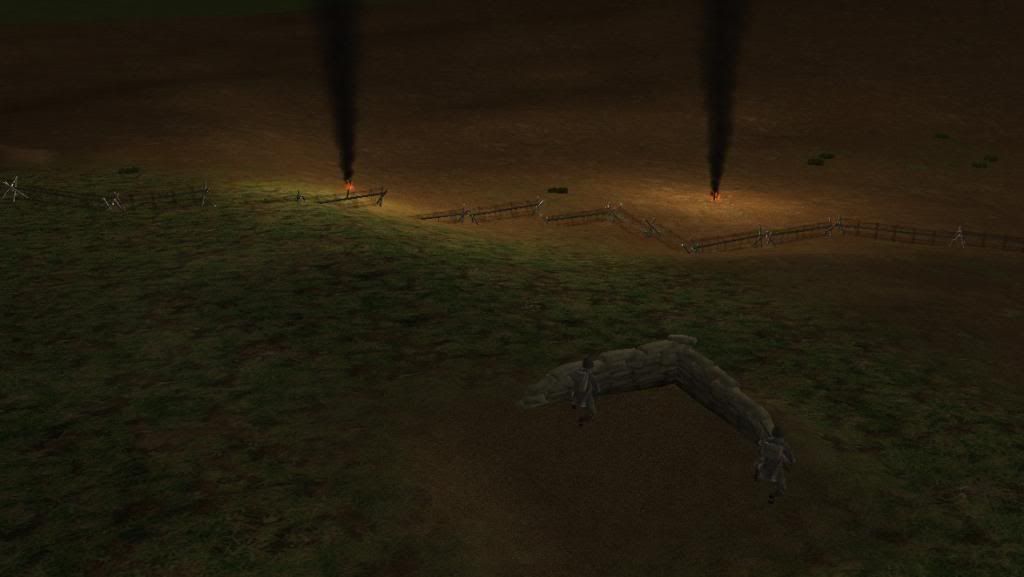
-
While writing this, it occurs that I have never experimented with sunken, immobilized Half-Tracks.
Throw a few rounds at some HTs sited along your trench lines LLF. Maybe they will help some.
The answer to hardening bunkers against 81mm turns out to be quite simple, with no trees needed (might need them to shrug off the 120mm heavies though!)
Per my earlier tests, 81mms cannot (AFAIK) destroy bunkers outright, but near misses can cause substantial casualties (4-5 out of 9 max capacity) through the firing aperture to the occupants, who won't HIDE or Cower. Sandbags, walls and other barriers won't sit close enough to the bunker (or vice versa) to mask it.
The solution: stick a destroyed halftrack (or any other AFV) up athwart the vulnerable aperture. Zero casualties in 5 playtests in spite of numerous direct hits (the wreck was set ablaze twice, but there's no cookoff effects -- it just looks neat!). The track takes all the punishment, although the (Veteran/High) bunker occupants max out the Pin meter and suffer morale effects.
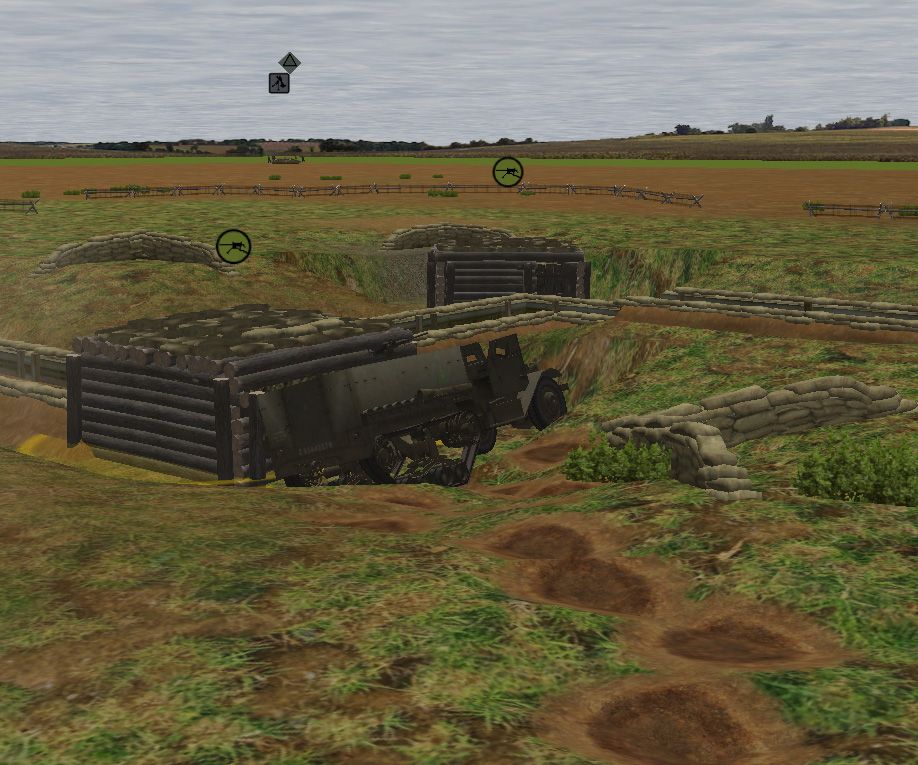
So it doesn't look quite so odd, I swapped the M5 Brit halftrack wireframe for a wood bunker. It's still a HT for all game purposes, just looks like a bunker.
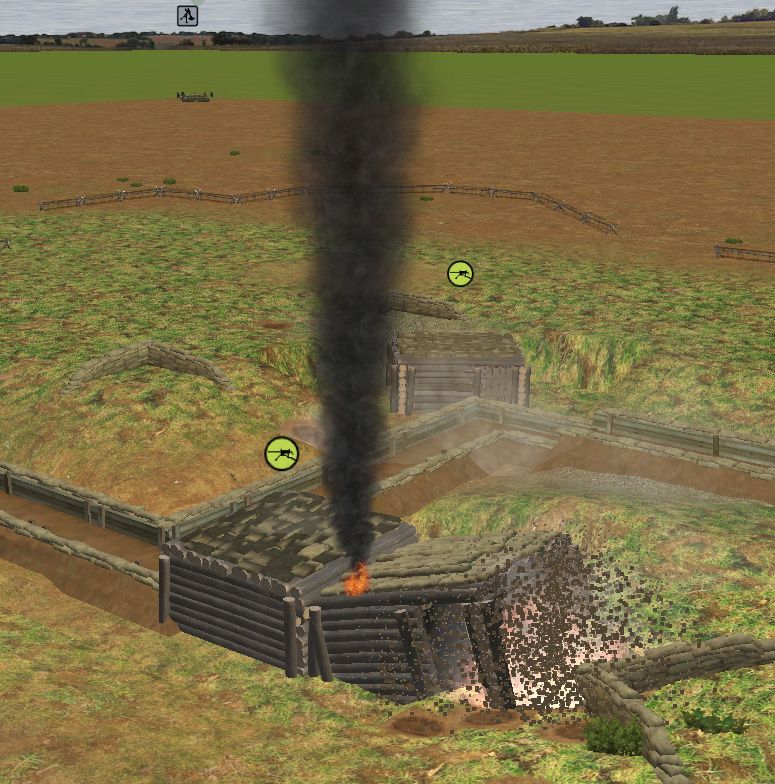
With that problem solved, I now move on to the 120mm indirect mortar barrage (1 tube firing a Maximum 51 shells including spots), which has more devastating effects on both the (Point) target bunker and its surroundings, as you can see from this screenie.

The bunker was KOed and the squad evacuated, only to be massacred in the nearby trenches. 9 of 9 casualties. And the next bunker over was also killed and it wasn't even a target.
-
Alleluiah brutha!
-
Well now, Comrades Minh, Nguyen, and I wait until nightfall and then leap out of the halftrack and take the French by surprise!
-
Great stuff, very ingenenious, although it looks a little too large and elaborate for my purposes. Thanks for the info on the trees; you are right that the various redoubt hills were deforested to clear fields of fire (and to provide raw materials for fortification which were in short supply).
The problem I've found with walls and hedgerows is that, like trenches, they are in the centre of each square so trenches cannot sit in close proximity to them, which negates a lot of the benefit.
Another "cheat" that's occurred to me is to have most of the defenders appear in the trenches as reinforcements following the initial barrage (as if exiting underground shelters not explicitly represented in game. If the barrage is intense, they can appear with Weakened fitness, lowered headcounts and reduced morale state. I'd rather not resort to this though, since to me a key part of the DBP "wargaming experience" is being "in the boots" of your poor copains as the Viets rain hell on them then assault the wire.
-
I refined my 81mm test vs infantry in trench test as follows:
A single 81mm mortar team (Regular), direct Area firing on a 30 meter straight line of trench sunk 2 meters into the (Damp) ground containing 10 Canadian paratroopers ordered to Hide
Test 1. 4 ranging shots, 7 of 23 hit in trench, 6 killed
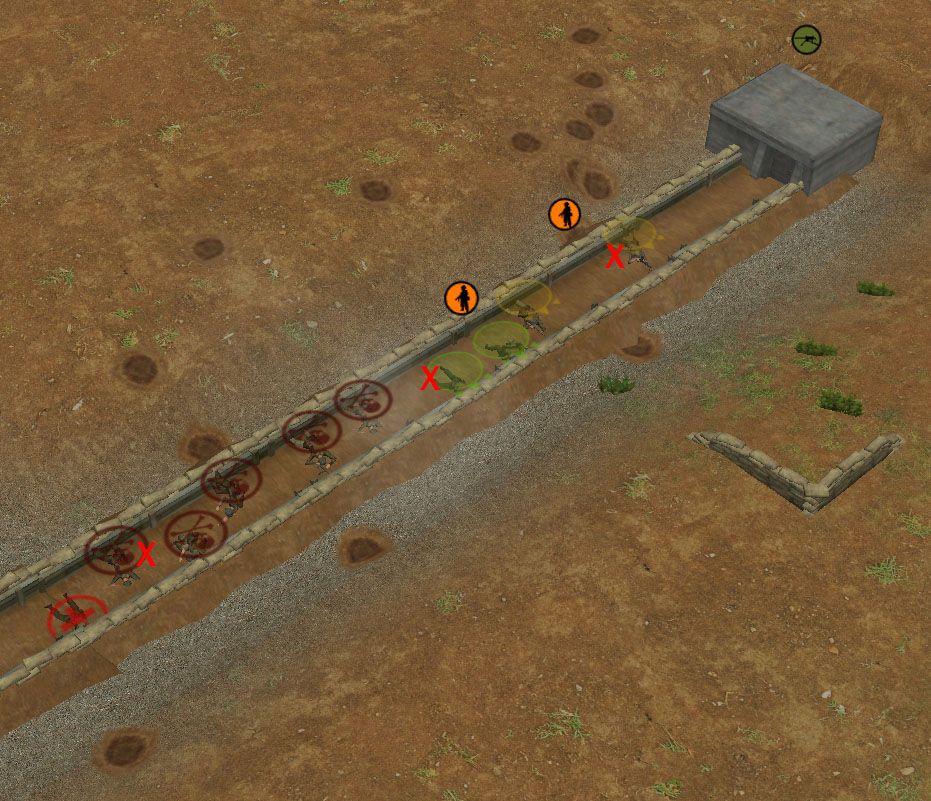
Test 2. 3 ranging shots, 8 of 24 hit in trench, 5 killed
Test 3. 5 ranging shots, 10 of 22 hit in trench, 5 killed
Test 4. 7 ranging shots, 7 of 20 hit in trench, 9 killed
Test 5. 5 ranging shots, 10 of 22 hit in trench 6 killed
For tests 6-8, I took the height of the trench to the same as the rest of the map. Rifle (area) fire from the mortar team may have inflicted additional casualties.
Test 6. 4 ranging shots, 12 of 23 hit in trench, 10 killed
Test 7. 4 ranging shots, 11 of 23 hit in trench, 10 killed
Test 8. 3 ranging shots, 7 of 24 hit in trench, 7 killed
For tests 9-12, I sunk the trench 2 meters again and added tiny rubbled barns (as shown) along the rear of the trenchline to see if it would provide additional cover
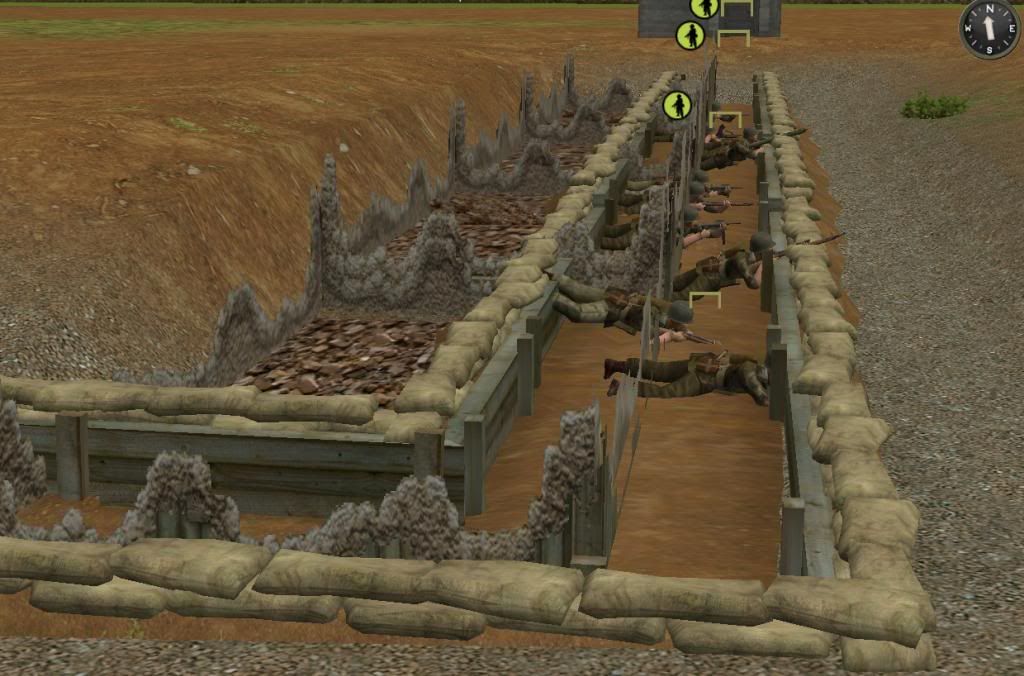
Test 9. 3 ranging shots, 7 of 24 hit in trench, 7 killed
Test 10. 3 ranging shots, 6 of 24 hit in trench, 7 killed
Test 11. 0 ranging shots, 12 or 27 hit in trench, 9 killed
Test 12. 3 ranging shots, 10 of 23 hit in trench, 9 killed
CONCLUSIONS:
1. In these tests, an intense barrage (average of 10 x 81mm HE rounds achieve direct hits on a 30m stretch of open trench -- creating a large explosion every 3 meters!) is routinely and consistently annihilating most of the target infantry -- casualties average 70%.
Which I suppose I expect, given that the victims are lying in a broad (2m wide?), shallow (<1m high) trench, where they are exposed to near miss shrapnel as well as direct hits, as opposed to a narrow (1m?), man-deep slit trench (not provided in the game). I'd still expect devastating casualties to infantry in slit trenches exposed to this intensity of bombardment, but at a guess it's more like 1:4 or less killed or maimed by blast and shrapnel, with others still able to fight even if debilitated by concussion, shock, bleeding eardrums, terror of being buried alive, etc.
I accept that a trained mortar team (regulars) could readily achieve a ratio of 1:3 direct hits while walking fire down a broad (2m wide?) trench, under the firing range conditions provided here -- short range, midday, firing with impunity. I doubt though that they could achieve the same results against a slit trench if they couldn't eyeball its exact position.
So it doesn't seem to me that the mortars are mismodeled; it's the poor bloody infantry that are deprived of proper holes to hunker down in. FWIW, I'd also expect a significant (10%?) dud rate for mortar rounds impacting in the Damp earth.
2. Sinking the trenches does help survival a little (it also protects from small arms incoming).
3. The proximity of rubbled buildings provides no additional benefit.
So it looks like my trenches are going to need to contain plentiful bunkers, deeply revetted into the ground to avoid being spotted, where the infantry will deploy initially and then leave to take their fighting positions once the barrage lifts.
My next set of tests will refocus on performance of said bunkers under both 81mm and 120mm mortar fire. Out of time tonight, but I'm wondering whether putting the bunkers under trees might help. The key question being: do airbursts impact the infantry in the bunker?
-
John, sweet Jesus, I give you an inch and you take a mile. You're now flooding a second thread of mine with wordswordswords and any response I write to you is iust going to elicit another torrent of verbiage. Let me try to be nice -- stand down for a while, please. Your comments are no longer helpful even though you think they are.
Briefly: the 105s were deeply buried and with tightly restricted fields of fire played little to no role in bombarding the "femmes" (maybe the first two) -- they shut down the airfield and hammered the main camp. Same thing for most of the 75 guns. The katyushas only came in at the very end. The bombardment weapons used in the fights for the perimeter CRs were the ones I am testing -- mortars up to 120mm and RCL guns. So voila! all those words you posted aren't relevant. And I don't care about the quad 50s either since the Vietminh didn't use them in bombardment which is the point of this thread. The only one.
And you have limited experience playing CMBN, by your own admission, and none at all with scenario and map design. So I fail to see how giving you bunker specs is going to help you "make suggestions" that are useful to me.
Please show some self control by not responding to this explanation, which is as civil as I can make it.
If you are determined to sound off on Dien bien Phu for pages upon pages upon pages you really should read Martin Windrow's book "The Last Valley", which has IMHO displaced Fall as the definitive history of the battle. It contains much of the grog detail re weights of fire you're trying to reverse engineer at length here. Get it via your local library.
-
My screenies are also on Botophucket, but yeah they changed it. Now, when you go to your "library" (fka "album"), left click the little gear wheel that appears in the top corner of each thumbnail when you mouse over, then you'll get a popup -- pick the linky that says "Get media links". That'll give another popup with the img data to copy-paste over.
C3K, I have yet to see the occupants of a bunker Hide (or take cover on the floor) other than while Cowering as a result of incoming. Or is the wireframe visual just not showing something that they're really doing? That's good to know, if true.
I can certainly sink the bunkers 4m down out of sight, and if their purpose is shelter from shells (not fighting positions), also cover their vulnerable vision slits with high stone walls or hedgerows.
-
But before readers simply dismiss these tests as a triviality, keep in mind that for about 5 weeks following the "Five Hills" battle, the Viet Minh were able to emplace direct fire weapons (mortars and RCLs) in overwatch over the French positions (at equal or higher elevation), at ranges of 250-300m, often less! While they had to contend with vigorous French counterbattery fires which confined their intensive operations to nighttime, it is also well documented that their presence made daylight movement very hazardous for the defenders.
However, even under such close conditions there is no record of them blasting the French out of their holes. The purpose of the bombardments was to suppress the defenders to support infantry assaults, not to annihilate. Which it could not accomplish against even primitive entrenchments, even using many guns firing hundreds of rounds into small areas.
-
Good post, John, thanks. I guess the question that springs to mind at once is: is the overmodeling in my tests a function of the idealized firing conditions? -- i.e. the shooters are able to sit in a secure position at midday and bombard a target set 200-250 meters away with impunity. As many real world mortarmen have attested here, given firing range conditions, they can drop "a pickle in a bucket" firing direct at ranges up to a km. And a high velocity cannon is like a sniper rifle at that range.
So if your data (or some other data) represents the expected real world outcome (design for effect benchmark), does changing the firing conditions -- increasing distance, lowering visibility, allowing counterfire, etc. shift the results toward the benchmark?
-
Here's the one you've been waiting for, hot off the presses.
My third test used an 81mm British Airborne medium mortar team (Regulars) with a forward observer (Vet)
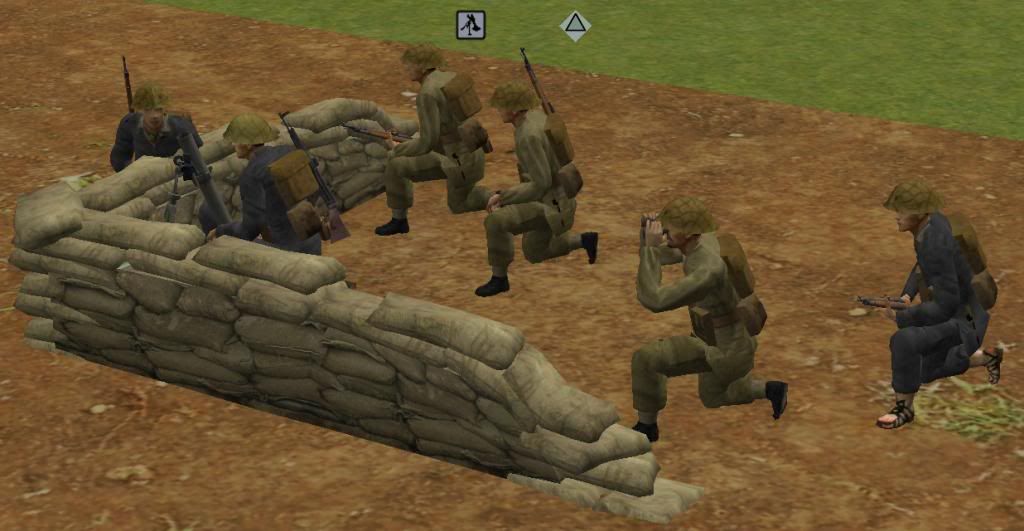
Test 1. Area fired on bunker 2 site (never spotted). 4 ranging rounds then 9 of 23 shots hit, KOing bunker and killing occupants
Test 2. Indirect fired on 2. 2 ranging rounds then 9 of 27 FFE shots hit, killing 2 of 3 occupants.
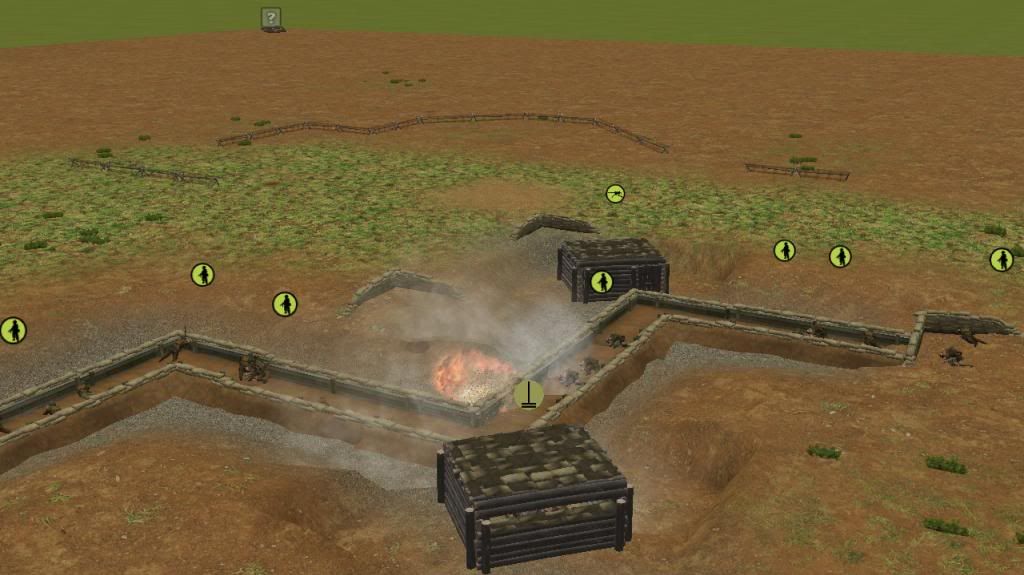
Test 3. Direct fired on 2. 5 ranging rounds, then 10 of 22 shots hit, killing all occupants
Test 4. Direct fired on 2. 4 ranging rounds, then 8 of 23 shots hit; 1 occupant lightly wounded
Test 5. Direct fired on 1. 4 ranging rounds, then 8 of 23 shots hit, killing 3 of 4 occupants
Test 6. Direct fired on a 30 meter segment of trench, "walking" target along trench (red X's in photo); 4 ranging shots, then 10 of 23 shots landed in trench, killing 7 occupants
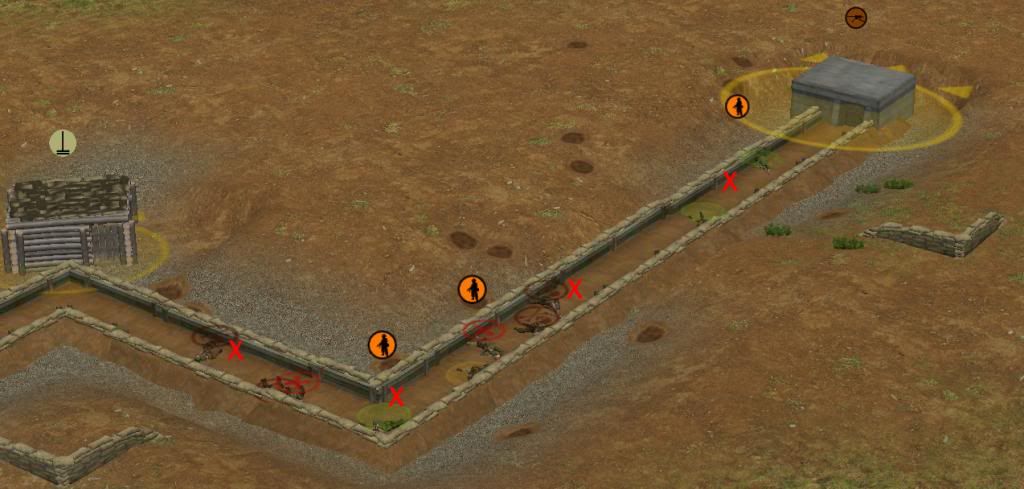
Test 7. Direct fired on a 40 meter segment of trench, "walking" target as before; 3 ranging shots, then 8 of 24 shots landed in trench, killing 7 occupants.
I also ran a couple of plays playing the French side; the VM mortar failed to shoot at my forces unless I UnHid and took some pot shots first -- it then fired a few rounds in reply and fell silent again.
EARLY CONCLUSIONS:
a. The bunkers seem to provide reasonable protection against mortar fire; a lot of the casualties are taken through the firing slit (it would be nice to have one that's just an all round shelter). 27 direct fire shots under ideal conditions is pretty heavy punishment.
b. The trenches provide very weak protection against mortar fire; again, 27 81mm shells is an intense barrage on a small segment, but it consistently caused 50% casualties to the (Hiding) men under it. That's higher than I'd expect for men in trenches. I'll rerun the test a few more times to reconfirm the results. Not sure what I can do to mitigate this, other than to stick the men in revetted bunkers (dugouts) along the trench line and exit them once the barrage lifts.
c. Once they range in, mortars seem to land at least 30-40% of shells right atop a point target; this is fairly consistent.
-
My second test used a 2 Inch British Airborne light mortar, representing the homemade, Japanese and prewar French weapons in the VietMinh arsenal
This weapon took 4 ranging shots on the closest bunker (215m), then hit it with all 8 of its remaining rounds, but caused no casualties to occupants. I discontinued testing at this point; I will try again later with a US 60mm (which was used by the VietMinh).
-
Let's start with the most lethal weapon: a direct fire high velocity gun. I used a British Airborne 2lber (57mm) AT gun, a highly accurate flat trajectory weapon with HE and AP ammo. I have modded it to look like a 75mm recoilless rifle of the type used by both sides at Dien Bien Phu. Gun crew is Green.
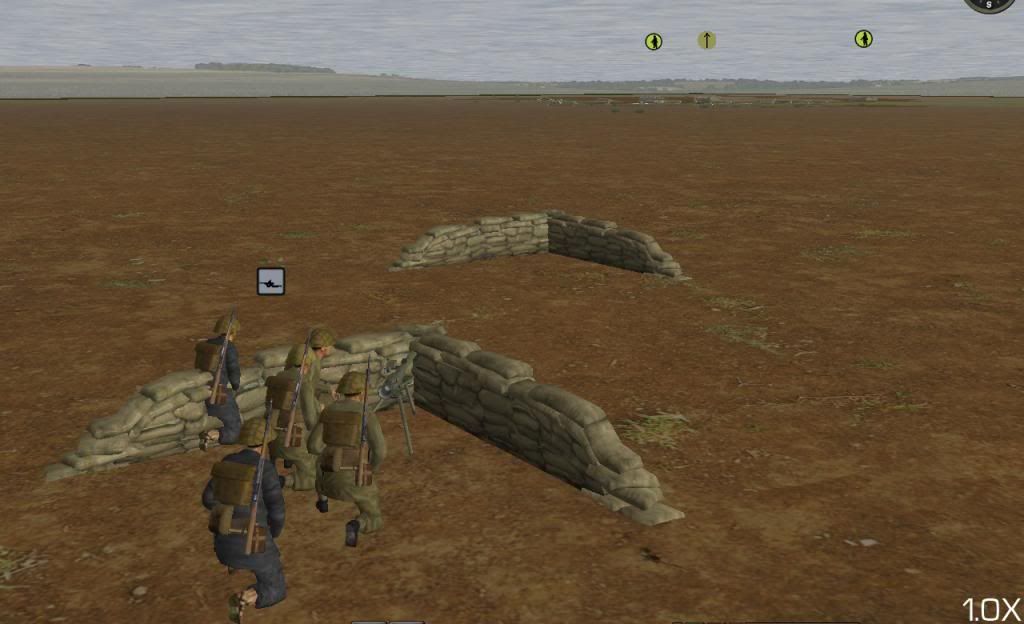
I ran four plays of 10-12 minutes each. The results were similar enough that I didn't see value in running more. I also ran a 30 minute playthrough as the French defenders, and found the results consistent with these tests.
Test 1. Gun spots all 3 bunkers quickly, but does not fire. I order Area fire to a point beyond each bunker.
1.(left bunker, 215m). Area shots 1-2 penetrate, shot 3 sets it afire.
2.(centre bunker, 230m) Area shots 1-5 overshoot, shots 6-8 penetrate (bunker KOed).
3.(right bunker, 250m) First Area shot sets it afire. This is a cement bunker!
Bunker 1
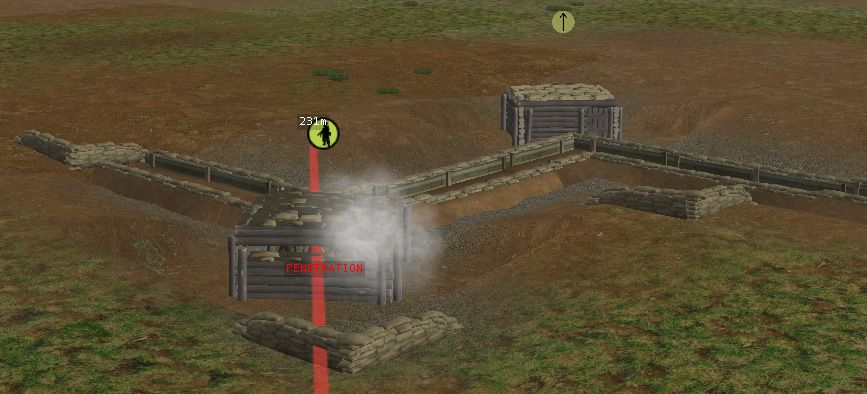
Bunker 2
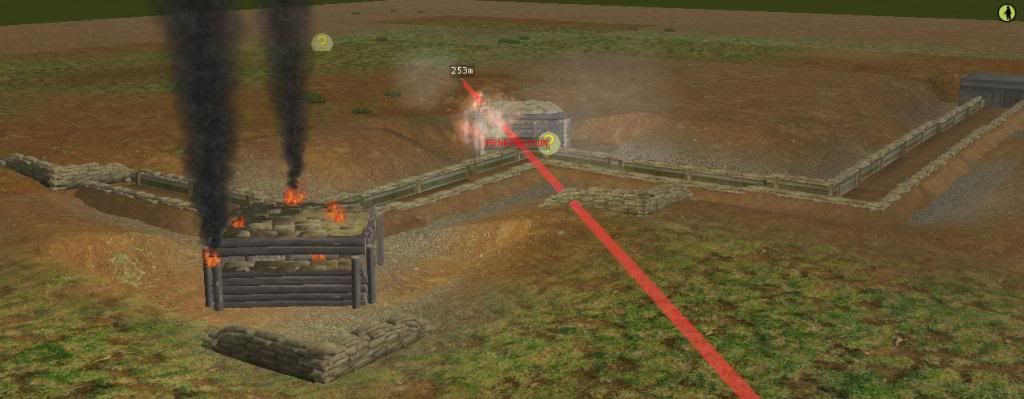
Bunker 3 (revetted 3 meters below the range -- a 4 meter depth would put it out of sight of the shooter).
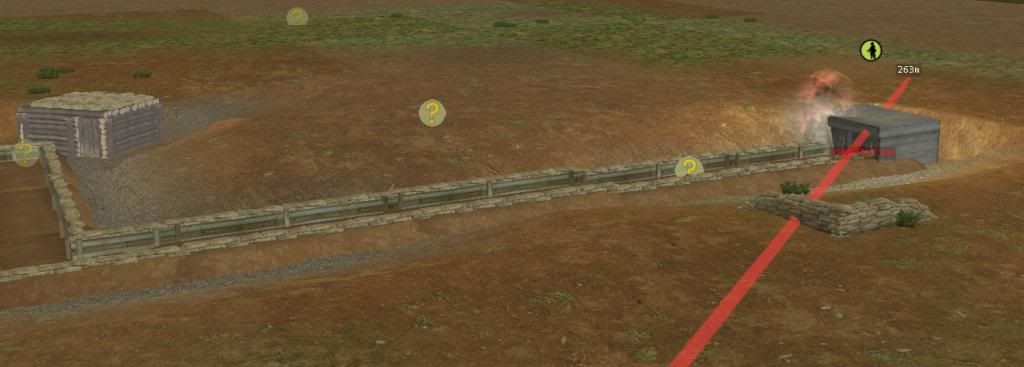
Test 2. Gun spots bunkers 1 and 2 immediately and fires on 2.
2. 5 shots in 1 minute -- all penetrate and shot 5 KOs.
1. Area shots 1-2 penetrate and set afire.
3. Never spotted - 5 area shots do not reveal it.
Test 3. Gun spots bunkers 2 and 3 within 30 seconds. Order Area fires
3. Area shot 1 sets afire
2. Area shots 2 and 4 hit - KO. others overshoot.
1. Never spotted.... I didn't bother trying area fire
Test 4. No area fire or other commands needed.
2. Gun spots immediately, KO'd in 2 shots (all penetrate)
1. Gun spots in minute 2, KO'd in 4 shots (all penetrate)
3. Gun spots in minute 3, KO'd in 4 shots (all penetrate)
And here is a surviving French para, stunned at how easily his "cement blockhouse" was destroyed and set ablaze. Note the Kilroy graffiti visible through the door.
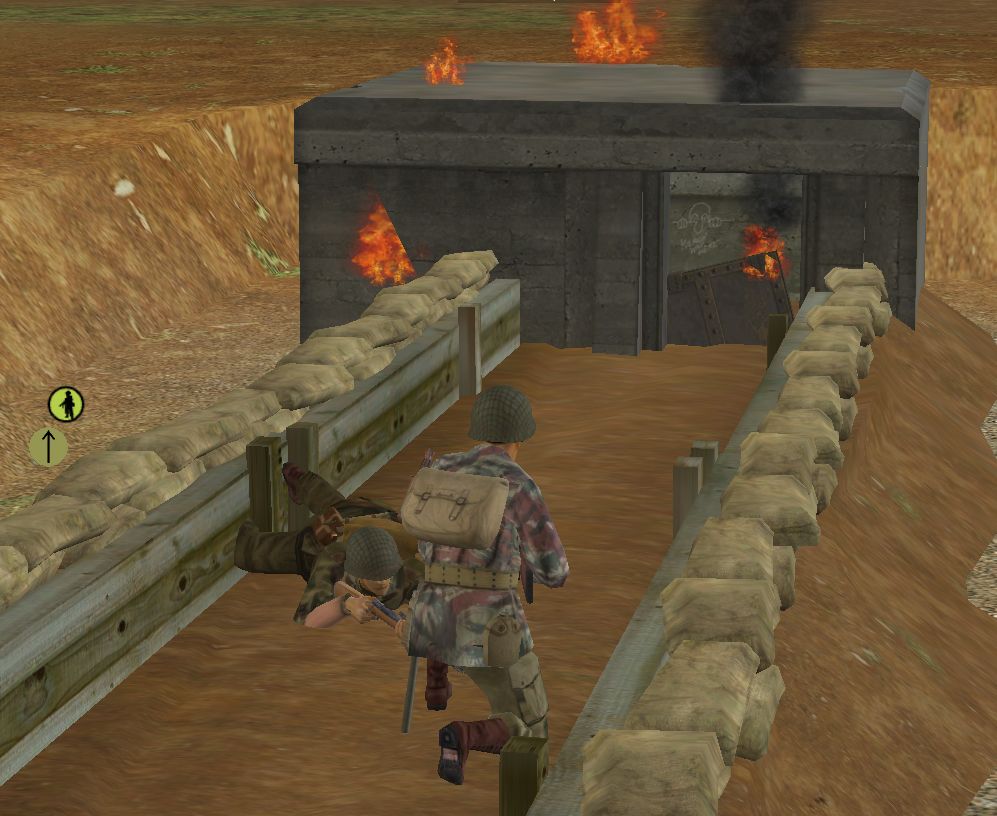
EARLY CONCLUSIONS:
Just reconfirms what we already know; bunkers are virtually helpless against flat trajectory guns, even of lighter calibres, and are knocked out very quickly. Putting them in hull down positions does nothing to extend their lives -- even bunker 3, whose roof is the only part visible was killed instantly. Their firing slits are not their weak point (like you'd expect) -- they get killed just as quick from behind or the sides.
The only protection seems to be to hide them deep in the earth (4 meters) or behind crests so they aren't visible from a distance.
-
Nonetheless, I have set out to see how I can maximize the survivability of the fortifications we've got by sinking them into the earth and sticking them behind sandbag walls -- effectively placing them in hull down positions. Below is the test scheme I came up with, built on a flat pooltable map (default height 20m) -- I'll work in hills and crestlines later.
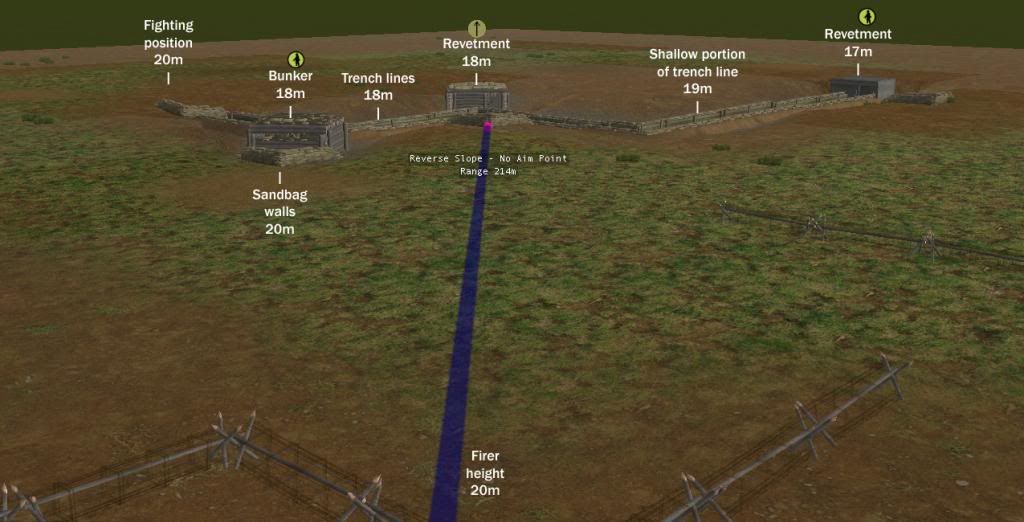
Here is what the scheme looks like to an enemy at the same height. Note that I have placed sandbag walls between each bunker and the enemy test shooter.

The sandbag walls also provide firing positions for the trench occupants. Basically, the idea would be to shelter from incoming in the (sunken) trenches and dugouts and then crawl up to fighting scrapes (as shown by the nearest team in the photo) to meet the enemy infantry attack. However, in this test case, they are actually able to spot and engage a distant enemy from the trenches in spite of the 1-2 meter lower elevation.

A platoon of "French" (Canadian and US) paratroopers is deployed in the trenches and bunkers shown, with AI orders to Hide (i.e. not to return fire). This creates a "firing range" situation for the enemy, who is also engaging from a close range location: 210-250 meters.
The next step is to test their performance against various weapons, and then reflect on whether what we are seeing makes sense in the context of the WWII era. I intend to test them with all the direct fire weapons used by the Viet Minh at Dien Bien Phu: flat-trajectory guns, bazookas (shreks), light/medium mortars and machine guns.
-
In playing around with my CMBN Dien Bien Phu project, I have been trying to see how closely I can replicate the (mostly poorly built) French fortifications in the "entrenched camp" and its various bastions (CRs). These consisted mainly of narrow slit trenches for shelter and communication, connecting sandbagged fighting positions/scrapes, dugouts and a few sturdy blockhouses.
The in-game bunkers are fairly weak: cement or wood doesn't matter much. Because the engine treats them as a kind of immobile vehicle (and their occupants as passengers), they are very easily spotted even in concealment terrain. And their cover values are poor; even small arms seem to penetrate them readily, causing their inhabitants to abandon them even. Steve has rationalized this in the past as these bunkers representing roofed over entrenchments hastily prepared by infantry in the field (as opposed to the more professionally engineered Westwall kind). In which case I'd ask: why include cement bunkers then? and if they're roofed over holes, why is their profile so high? All this also begs the question: when do we get the more durable kind?
Also, CMBN entrenchments offer comparatively poor protection (although better than non-entrenched) against HE plunging fire (mortars), even for units lying prone in them. Simply put, they are too wide (and not deep enough, obviously, owing to the "earth pimple" design FoW compromise). The game does not include narrow slit trenches which render their occupants basically invulnerable to anything but direct hits by small-medium calibre shells.

-
No problem Sublime, unlike old farts like me, Burke, Jason and JK, you have your life ahead of you. I am thrilled that someone in the new generation is still interested in these events and is willing to seek the truth, as opposed to falling blindly for 20/20 hindsight revisionist/ grievance claptrap, dumbed down milChannel pap, or worse, conspiracy theories.
-
*Sigh*
John, once again, there is nothing really new here, that map included... I linked to the original earlier. Eventually, I suppose that if you post enough verbiage, on the monkeys-on-typewriters principle, you'll end up replicating Martin Windrow's book in its totality in this thread. I already have over a hundred pages of detailed notes. Unlike you though, I don't feel a compunction to copy-paste them all here.
You have clearly appointed yourself my (web) research assistant, but how many ways do I have to say it: your "help" is not particularly welcome, as it is so voluminous and so scattershot. Together with all the political polemicizing by others, this continuing mess of links and commentary is making this thread unreadable.
I will likely start a new thread on my DBP scenario design, and if you continue to deluge it, I will complain to the moderators. Or simply not waste my time posting here at all.
-
Well, Im sure the statistics are nowhere near as comprehensive seeing as how it was 300 years ago as well. doesnt matter - insert your favorite civil war and you'll see much the same stuff.
No, you will look in vain for widespread "cleansing" of collaborators following the American Revolution, although a number of Tories who found themselves in majority Patriot areas (and probably fled), then lost their property for being on the wrong side. In those days, being deprived of your property was pretty serious, and was quite enough incentive for these folks to move to Canada or the Indies (some of my ancestors among them, btw). The exception of course was the grim fate of those Iroquois tribes who had fought for the British (and had committed some atrocities in doing so).
Recall, the American Revolution was different in that the "revolutionaries" represented a majority of the existing political and economic establishment, as opposed to a previously marginalized group seizing power and displacing (or killing) the former elites in the name of the masses (a la France, Russia, etc.).
In addition, keep in mind that your average Tory lived in an area where the majority of his neighbours shared his opinion. Whole areas of the 13 American colonies remained Tory during the war, whether because their natural economic interests (commerce) lay with Britain or because their leading families retained close links with the mother country or simply stuck to the ancient principle of King and Country, and the common folk followed suit. But once the war ended, it's not like these populations were "cleansed" out by some human wave of Patriots sweeping down from the hills and hollers -- they were simply required to pledge allegiance to the new nation, or else settle their affairs and leave.
-
That is certainly one perspective on how the Vietnamese fought the war, but I am gonna respect LLF's wishes this time. If someone cares to open this up in the general forum assuming BF doesn't bounce it for politics fine, but I am gonna try to stay outta this one.
Appreciated, SBurke, but at this point it's hopeless. I am going to let folks say whatever they like here and then restart a different thread on the scenario design.
FWIW, I agree with JasonC. By 1971 the Viet Cong had shot its bolt. The 5 year US ground war, however costly and frustrating, had depleted the ranks of rural guerrilla fighters -- ambitious "main force" operations and the Tet offensive had accelerated that. Simply put, the Communists were running out of grown men capable of holding rifles and planting mines. ARVN and the security forces (secret police) were getting better and better at identifying and neutralizing (killing, detaining) key cadres. The much ridiculed strategic hamlet program was actually working. ARVN forces were increasingly capable of going anywhere in the country they liked (albeit at some cost) except the underpopulated highland areas.
Again, just in my own opinion, the Republic of Vietnam (South) would have survived a la South Korea had Nixon hung in there with a smaller US ground force for about 2 more years (~1974) -- e.g. keeping 2 Marine divisions in I Corps (Da Nang / DMZ) plus SpecOps and tactical air power (stopping the militarily pointless bombing of the North) and, of course, continued supply and training. For example, Lam Son 719 (the incursion into Laos) would likely have had a very different outcome had a larger expeditionary force of Marines been bolstering the ARVN forces; they could have trapped and severely mauled a couple of NVA divisions.
After a year or two of this (1973), the DRV might well then have been inclined to cave to Chinese pressure and go home, leaving the remnant VC (and the Khmer Rouge) to be bribed into rejoining society or progressively exterminated, forsaken by the weary population. The Hanoi Politburo were certainly not Mao's lapdogs, but if China shut off the supply tap to make nice with America the Russians weren't about to run the blockade into Haiphong just to keep the war going. There would still have been sporadic fighting and terrorism into the 1980s and certainly American/SEATO troops manning a DMZ just as in Korea, but South Vietnam would have survived and Cambodia would have been spared its bizarre holocaust.
Final note: Nothing I have said above makes any kind of judgment on who "shoulda" won, or which parties best represented the hopes, dreams and aspirations of cute Vietnamese children. They were all thugs. But at the end of the day, it is simply indisputable that Commies and Jacobins have a vastly bloodier track record once they actually attain power than any kind of ancien regime.
-
Ok. What about land? Can craters' date=' that are created near a water tile flood? I guess that is what I was trying to say in my previous post.
 [/quote']
[/quote']Based on my Makin beach landing scenario, I can categorically say NO -- even a gigantic aerial bomb crater right next to the water's edge doesn't "fill up".
Oh, nice work Ian.
-
GaJ is correct in that the AI will decide on its own (and the Order cannot influence):
1. Which squares in the Order's painted destination zone will be occupied -- as many as possible, it seems. Each unit's specific destination square(s) are selected randomly from among those in the zone (i.e. without reference to how near that destination is to its present position -- this is a gripe of mine).
2. The timing and route (generally fastest) of the AI Group's movement. Generally weapons teams and HQ units in an AI Group move later than infantry squads/teams (provide overwatch). When the Order objective is distant, units will pause every 75 (?) meters or so, creating a series of "bounds"; occasionally they will leapfrog each other (bounding fire and movement), although this seems random, not deliberative.
3. What speed to use on the moves: Quick, Hunt (rarely) or Slow, depending on the volume of enemy fire. Quick will become Move (walk) once units are Exhausted. The type of Order selected seems to impact that choice a little, but I haven't been able to discern how (i.e. Max Assaulting units will often run, Fast units will often crawl)



Fortification Durability Tests
in Combat Mission Battle for Normandy
Posted
You know what, I may actually give this a try -- reskin an immobilized halftrack or carrier as a trench and bury it hull down. At least the MG gunner will "prairie dog" (Un/Button) quickly up and down between shots, the way ordinary infantry under fire ought to do instead of just sitting there upright (Spotting) waiting to be picked off. Unfortunately though, halftracks are swiss-cheesed by small arms just as easily as Fortifications.